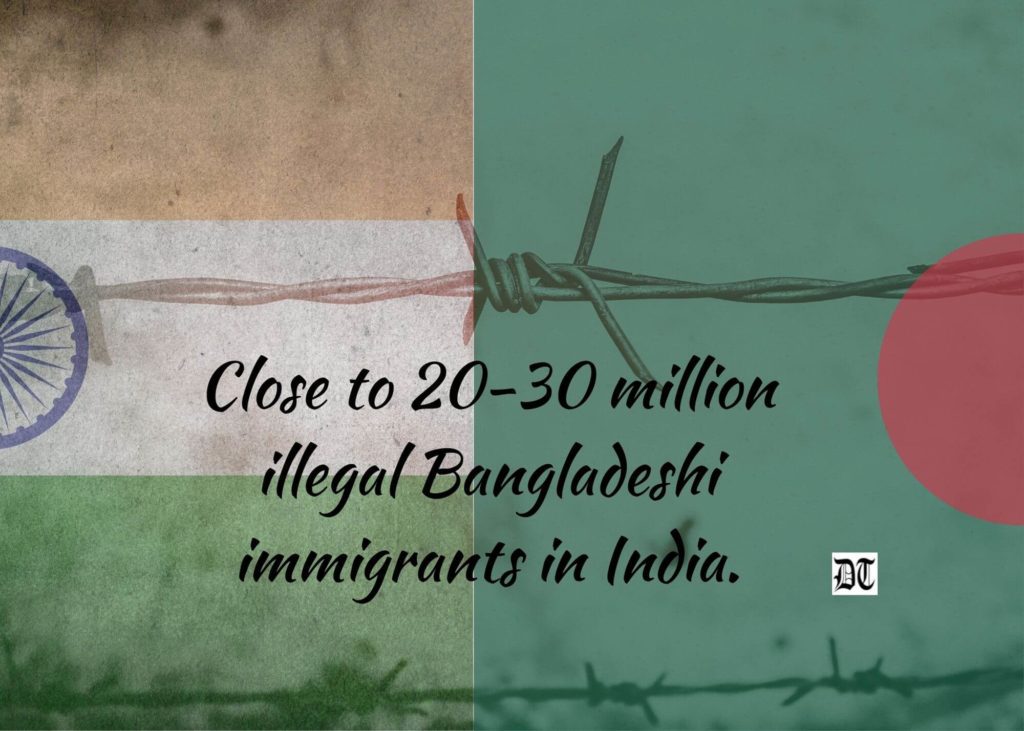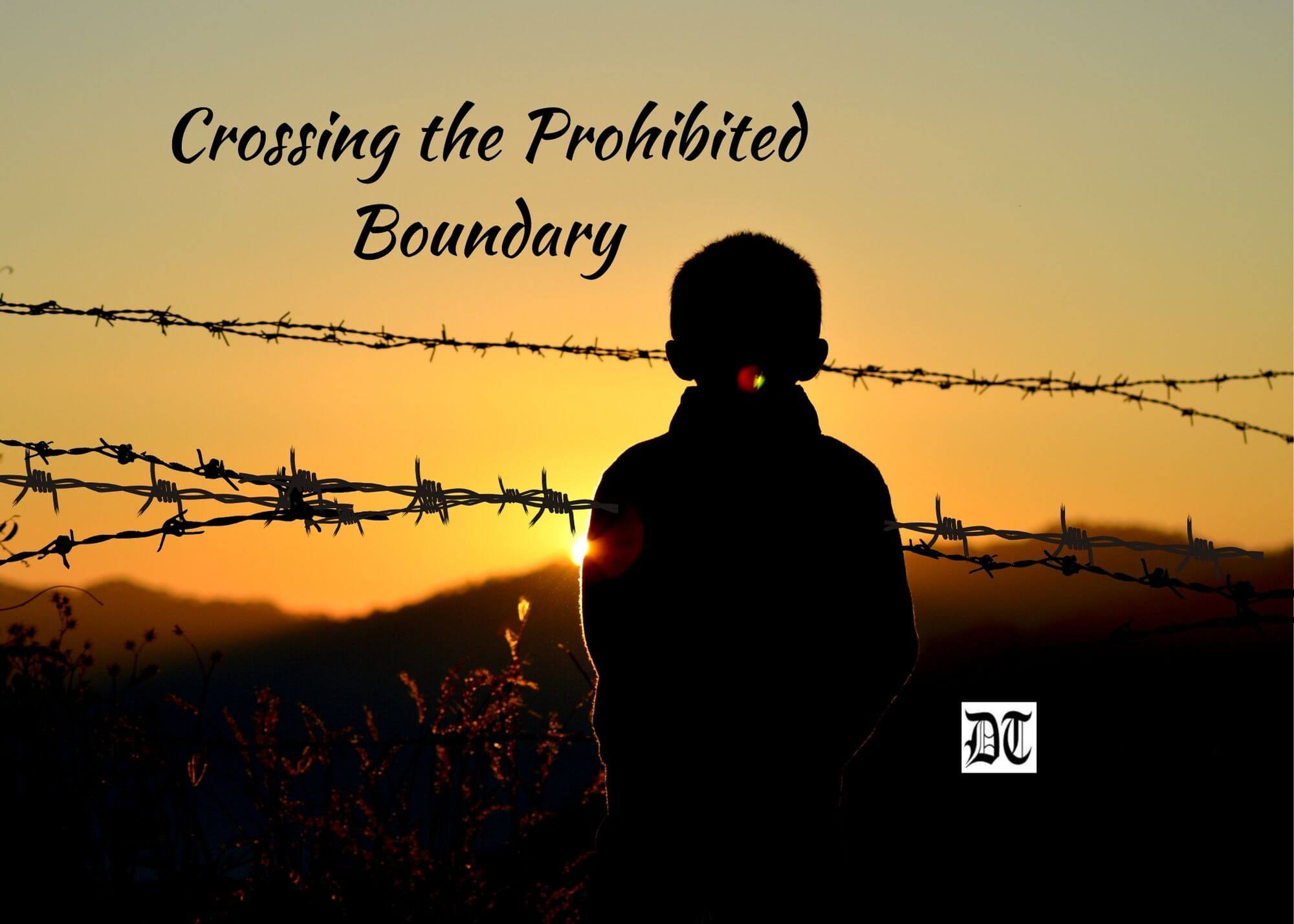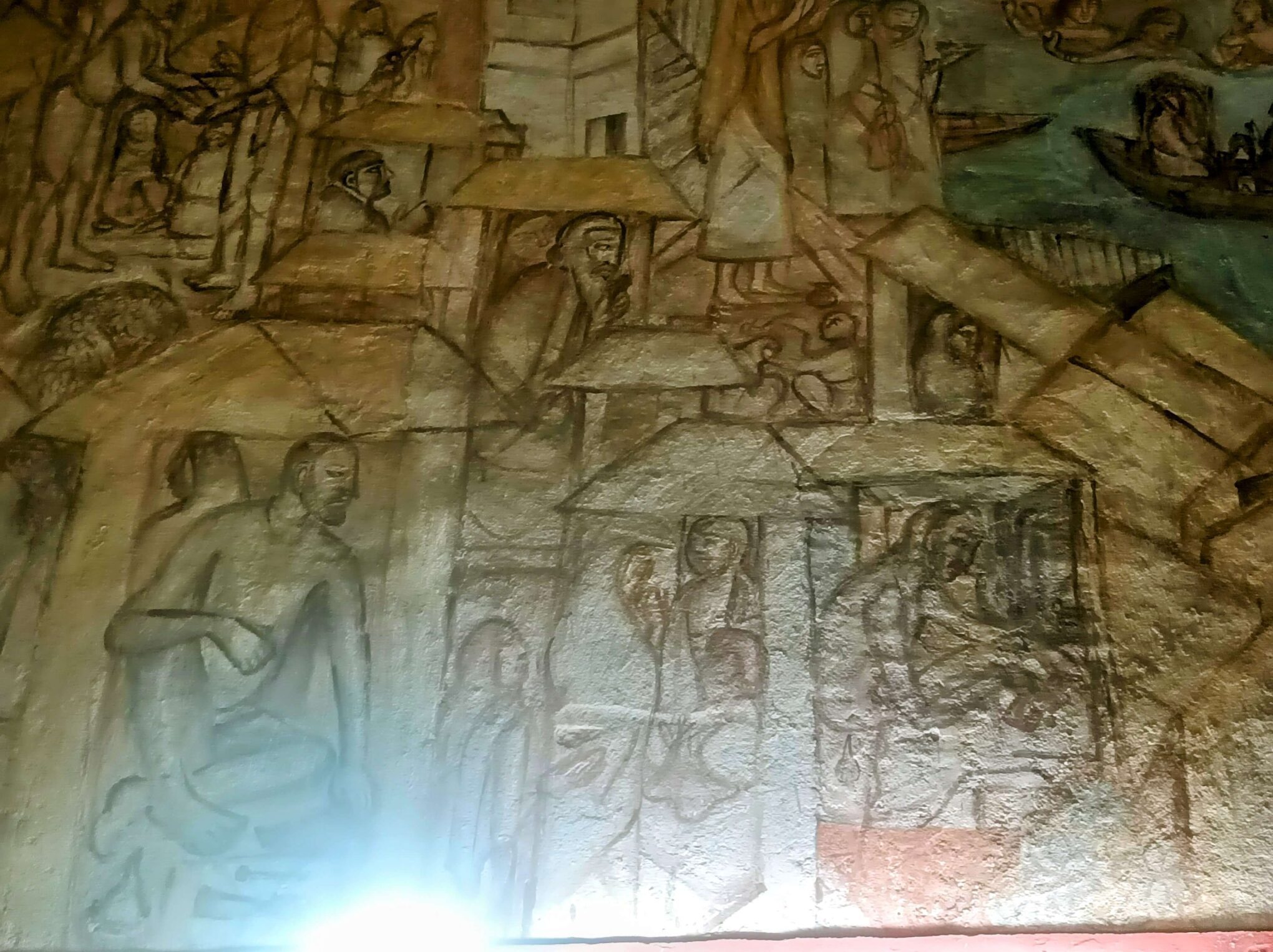The issue of illegal immigrants has several ramifications. Madhumanti discusses this issue, brilliantly, in the backdrop of global phenomena. Indo-Bangladesh, the fifth longest land-border in the world, is porous. She dwells on the causes of immigration from Bangladesh and shows a way to solve it amicably. Here’s an in-depth analysis.

Four times US president, Franklin Roosevelt could never forget his ancestral roots – in Denmark and in France. As I am putting down my thoughts on this topic, his famous words ring in my ears: “Remember, remember always, that all of us, and you and I especially, are descended from immigrants and revolutionists”.
My ancestors were also immigrants and my roots remain in Dhaka (now in Bangladesh). Hence, I strongly feel, unless there is a very good reason, nobody leaves their home – their original homeland. Immigration is a worldwide phenomenon since time immemorial. According to the United Nations, almost 200 million individuals, about three per cent of the world’s population, live outside the country where they were born. Over 100 million migrants live in the more developed regions of the world, including 9 million in Northern Europe, 22 million in Western Europe, and 38 million in the United States. Successive waves of immigrants in these countries kept them demographically young, enriched their culture, added productive capacity to the nation and enhanced their influence in the world.
In the United States, the immigrants have been bringing innovative ideas and entrepreneurial spirit to their economy. In Canada, according to a study of the Conference Board of Canada, immigrants helped in boosting Canada’s stature in innovation, which ranks 14th out of 17 industrialised countries. In India, the Noble laureate Amartya Sen has his origins in Bangladesh. Therefore, immigration is not unwelcome in any country but illegal immigration has always had undesirable consequences. The policymakers of any country need to counter this diplomatically and through policy framework. Having said that it is an extremely difficult job. Journalist, R Jagannathan pointed out, “The pressure of land and population on the Bangladeshi side is simply too immense to contain them there. This is why immigration, legal or illegal, has been consistently in one direction – towards India – for over a century now.” Therefore illegal immigration is a major bone of contention between Bangladesh and India.
Porous Indo-Bangladesh Border
Geographically, the fifth longest land-border in the world, the 4096 kilometers long India-Bangladesh border is highly porous and densely populated. The land is extremely fertile and is cultivated right up to the border pillars. Sometimes the border passes right through the villages, even building constructions. As a result, members of the same ethnic or religious community live on either side of the border. Given the situation, it is almost impossible to stop illegal immigration without strict measures and co-operation from both the countries. An illegal immigrant in India is a person residing in the country without an official permission as prescribed by Indian law but those who are explicitly granted refugee status do not fall under this category.
Historically, decades prior to partition, there was a flow of Muslims from East Bengal to states like Assam, where they came in search of a better livelihood. Under colonial rule Assam was sparsely populated and the British, who wanted to exploit the resources from the region brought labour from East Bengal. Internal migration was normal within East Bengal (now Bangladesh), West Bengal and Assam. In 1947, the partition triggered a large exodus of people from East Pakistan (now Bangladesh), and most of the immigrants were Hindus. Second mass migration was in 1971. The Bangladesh Liberation War and unending political and economic turmoil in Bangladesh in the following decades compelled many Bangladeshis to seek refuge in India. The vast majority of them were illegal. During the Bangladesh Liberation War at least 10 million Bangladeshis crossed the borders into India illegally to seek refuge from widespread rape and genocide. Most of them migrated to the Border States, particularly to West Bengal and Assam. This matter became more visible in 1991 census. Muslim population growth rates in the Border-States Assam and West Bengal were found to be much higher than the growth rates of the local Hindu population even after adjusting for the usual higher growth rate of Muslims throughout the country. Realizing the ground reality, the Government of India had decided to make any person from Bangladesh, who came to India illegally till 1971 as legal. Therefore, this population is considered to be Indian and their rights are protected.
Causes of Immigration from Bangladesh
In order to understand what drives immigration from Bangladesh apart from the above two calamities, we have to analyse the basic causes. The major reasons are socio-political discord, natural calamities, communal riots, and poor economic prospects. Amongst these the economic issue has been the most dominant factor. In spite of deportation, preventing the flow of immigrants from Bangladesh has been very difficult. The porous border also makes it easy for deportees to return. Despite the economic progress Bangladesh has made since its independence, the country still remains one of the poorest in the world, with more than 40 million people living in utter poverty. Moreover, the trip to India from Bangladesh is one of the cheapest in the world, around Rs. 2000-2500, including the fee for the ‘Tour Operator’. As Bangladeshis are culturally similar to the Bengali people in India, they are able to pass off as Indian citizens and settle down in any part of India to establish a future for a very small price. The false identity can be acquired for a paltry sum of Rs.200-300.

According to some estimate, there are close to 20-30 million illegal Bangladeshi immigrants in India. No reliable numbers on illegal immigrants are currently available since no systematic surveys have been done. They are on electoral rolls and they acquire ration and Aadhaar cards by spending little or no money. They are no longer restricted to the bordering states of Assam, West Bengal, Meghalaya, Tripura and Mizoram but virtually everywhere.
State-wise Impact of Illegal Immigrants
Impact of illegal immigrants varies from one state to another. The Indian side of the Indo-Bangla border passes through West Bengal (2,216.7km), Assam (263km), Meghalaya (443km), Tripura (856km) and Mizoram (318km). If we analyse it state-wise, the most adversely affected state has been Assam. According to the historian Kanchan Gupta, “Assam is facing external aggression and internal disturbance on account of large-scale illegal migration of Bangladeshi nationals”. In Assam, agitation against immigrants started as early as 1979, led by All Assam Students Union (AASU). Their demand was to put a stop on the influx of immigrants and deportation of those who have already settled. It gradually took a hostile form and ethnic violence started between Assamese and Bengalis, mostly Muslims. By the end of 1982, the movement was escalated when the central government decided to hold an election in Assam without revising the electoral rolls, which was the demand of the agitators. The leaders of the movement called for a boycott of the election, and during the election period numerous violent incidents occurred – the Nellie massacre being one of the biggest. According to Antara Datta, this massacre was one of the largest and most severe pogroms since the Second World War. The Nellie massacre resulted in 5,000 casualties. Surprisingly, no investigation of the incident was ever been done. The AASU denied any involvement in the massacre, and since then there have been no instances of communal violence in Upper Assam. In 1985 the ‘Assam Accord’ was signed. This was a ‘Memorandum of Settlement’ between the Central Government and the leaders of the ‘Assam Movement’. The accord brought an end to the Assam Agitation and paved the way for the leaders of the agitation to form a political party and form a Government in Assam soon after. As per the accord India started building a fence along the Assam-Bangladesh border, which is now almost complete. However, Assam also has a large number of genuine Indian Muslim Bengalis. It is difficult to distinguish between illegal Bangladeshis and Bengali speaking locals. In some cases, genuine Indian citizens have been discriminated. This has been a highly emotive issue, especially in states like Assam, and one that cannot be ignored.
West Bengal is another state badly affected by illegal immigrants but remained mostly calm because of the vote bank politics of the successive governments – CPM and Trinamul. The illegal Bangladeshi migrants have been trickling down into many parts of rural Bengal, like Nandigram, over the years, and settled down as sharecroppers with the help of the then local Left leaders. The majority of these immigrants became tillers and so they lacked documents to prove the ownership of land. Hindu-Muslim proportion in the border villages significantly changed due to illegal immigration. Many of the one-time Hindu majority border villages have now turned into Muslim majority villages. Major political forces including Islamic fundamentalists operating in Bangladesh as well as in India have been encouraging Muslim infiltration to expand Islamic influence in the border region. A study of five villages – Gunarajpur, Keutsa, Mathurapur, Hogolbaria, Routbati shows a drastic increase in Muslim population. An investigation of 30 families of the illegal immigrants shows very high incidents of crimes like murder, rape, dacoity etc. Incidents of organized crimes in connivance with Bangladeshi Muslim and other criminals, coupled with no legal actions from the local administration (the police, the Panchayats etc.) and the party in power to keep intact the Muslim vote-bank forced many Hindu families to move to other interior Hindu dominated areas. The local Hindus have been selling their ancestral home at throw-away prices to the Muslims. The Bangladesh population in census 2001 and a contemporary Indian population survey showed during 1951 to 2001 the growth of Muslim population in Bangladesh was 244.68% vis-à-vis 23.16% growth of Hindu population. Opposed to this, in West Bengal during the same period growth of Muslim population was 310.93%, i.e. much higher than the Muslim population growth rate even in Bangladesh. This clearly indicates massive Muslim infiltration from Bangladesh to West Bengal. Now ethnically, culturally, linguistically and religiously identical population inhabits almost both sides of the Indo-Bangladesh border region. The Islamic fundamentalist orientation through madrasa education, Islamic Jalsa (fundamentalist preaching for Islamic consolidation), anti-Indian propaganda by hate speeches and literatures mostly from Bangladesh, alienated other religious sects and ethnic groups. It is also strengthening the Islamic militancy and Inter Services Intelligence (ISI) network in the region. This is not only weakening our national security and integrity but also widening the communal division as well as deteriorating the moderate Muslim ideals. The entire process is damaging the secular fabric of our civil society leading to further erosion of social harmony. Apart from illegal immigrants a large numbers of smugglers regularly cross the border along West Bengal into India. They mainly engage in smuggling goods and livestock from India into Bangladesh. Moreover, Bangladeshi women and girls are trafficked to India and via India to Middle East for forced labour and commercial sexual exploitation. The Centre for Women and Children Studies estimated in 1998 that 27,000 Bangladeshis have been forced into prostitution in India.
In Meghalaya, according to official statistics, in the five years (from 2008 to September 2013), 18,951 Bangladeshis were ‘detected’ in the state. Out of which 978 infiltrators were ‘prosecuted’, and the remaining 17,973 were deported. The state has abundant mineral resources, particularly coal and limestone, and these are mostly embedded in areas lying within East Jacinta Hills, EastAgro Hills districts. Illegal immigrants mostly come to work as labourers.
As of today, an uneasy calm prevails in Meghalaya as pressure groups and the government have been at loggerheads over the inner-line permit (ILP) issue. Inner Line Permit (ILP) is an official travel document issued by the Government of India to allow inward travel of an Indian citizen into a protected/restricted area for a limited period. While the groups are pressing for the implementation of the ILP to check influx and illegal immigration into the state, the government has suggested other mechanisms like the proposed Meghalaya Regulation of Landlords and Verification of Tenants Bill.
Tripura, a bulge of land protruding south into Bangladesh, is home to native tribal and Bengalis. Most of the Bengalis, who make up three-quarters of the population of 3 million, arrived as refugees from Bangladesh after its independence in 1971. There are two main separatist rebel groups, the National Liberation Front of Tripura (NLFT) and the All Tripura Tiger Force (ATTF). Both want independence for the tribal areas of the state and the removal of Bengali immigrants, and both have attacked the Bengali-speaking community as well as kidnapping their political opposition. Attacks on Bengalis in northern Tripura have displaced tens of thousands of Bengalis, who are not illegal immigrants. Another major cause of displacement of Bengalis was the building of a fence along the border with Bangladesh, during which tens of thousands of Bengalis were evicted from their homes.
Sikkim and Mizoram state governments are somehow doing better than the rest, by remaining solid as rock while handling illegal immigrants from Bangladesh.‘Temporary ILP’ is required for entering Mizoram through any of the check gates across the inter-State borders. Typically, a ‘Temporary ILP’ is issued to visitors, which is valid for 15 days, and can be extended another 15 days, with the possibility of extending it to one month in exceptional circumstances. However, with the sponsorship of a local resident or government department, a ‘Regular ILP’ can be procured, which is valid for 6 months and can be renewed twice for another 6 months each. If arriving by air, an ILP can be obtained on arrival at Lengpui Airport in Aizawl.
Lately, Bangladeshi illegal migrants have been moving to Kerala owing to the high wages for unskilled and semi-skilled labourers, and also the presence of sizeable Muslim population in the state. The Kerala police are reportedly finding it difficult to check the influx of these Bangladeshi illegal migrants. Kerala State Intelligence officials said they found that a large section of migrant labourers in the state claiming to be from West Bengal were actually from Bangladesh.
Government Policies
Over the years, successive Indian governments have taken certain policy initiatives. In 1983, one of the most well known initiatives adopted by the Indira Gandhi government was the Illegal Migrant (Determination by Tribunal) (IMDT) Act, applicable to state of Assam only. This Act described the procedures to detect illegal Bangladeshi immigrants and expel them from Assam. The Act was pushed through mainly on the grounds that it provided special protections against undue harassment to the ‘minorities’ that were affected by the Assam agitation. In other states, detection of foreigners is done under ‘The Foreigners Act, 1946’. In 1998, the BJP Government ordered the construction of the Indo-Bangladesh barrier to stop migrants and illegal trade along the border.
In 2005, the Supreme Court of India struck down the IMDT law (1988) for Assam for non-performance and reinstated ‘the Foreigners Act of 1946’ throughout India to deport illegal immigrants from Bangladesh with no exception for Assam. Unfortunately, the IMDT did not perform as expected. From its inception in 1983 through to 2005, the tribunal identified a mere 10,000 illegal immigrants, and deported only 1,400. Indian government tried hard to convince successive Bangladeshi governments but in vain. One of the biggest hurdles in deportation of illegal immigrants was Bangladesh government’s consistent denial that its citizens are illegally crossing the border.
This compelled India to adopt the only option left and that was border fencing and a push back policy. In 2005, it was planned to extend the already existing barrier in Assam and to encircle West Bengal, Tripura and Mizoram as well. However, this measure had also not been fully effective as many areas still remained unfenced on account of delayed land acquisition and non-resolution of boundary disputes.
In 2011, both the countries signed, a joint Coordinated Border Management Plan (CBMP). However, the laxity in border patrolling displayed by Bangladeshi border guards has diluted the impact of this initiative.
Finally, on May 7, 2015, the NDA government had taken the landmark initiative. The Constitution (100th Amendment) Bill had been passed by the Parliament of India to ratify The Land Boundary Act (LBA) after 41-long years from its inception. Prime Minister Narendra Modi kept his promise that he had made to Sheikh Hasina on the sidelines of the United Nations General Assembly in September last year: “Aap mujh pe bharosa rakhiye (have faith in me)”. Hopefully this will secure the long stranded boundary and enable to curb illegal migration, smuggling and criminal acts across the border. In this light, a lasting solution will require further meaningful dialogue and cooperation between the two countries. India needs to take Bangladesh onboard for dealing with this problem. For this, the goodwill earned by the ratification of the LBA will be advantageous.
Illegal Migrants Worldwide
Worldwide, controlling influx of illegal migrants is not an easy job. In Europe, it is now the maritime area which is the focus of illegal immigrants. Nearly 220,000 illegal maritime immigrants were estimated in 2014. There are three main routes: the eastern route (Greece, Cyprus, Bulgaria, Romania), the central Mediterranean route (Libya, Italy, Malta, Tunisia) and the western route (Spain, Portugal, Morocco, Senegal, Sahara). New pressure is emerging from struggling African countries. In order to curb illegal immigration, EU is trying to implement the exceptional means since the traditional methods are not enough. They are trying to help the countries from which sea-travelling illegal immigrants originate. Police cooperation has been successful to some extent in Algeria, Morocco and in some African States. Settling populations via economic aid, supporting States that are rebuilding political democracy are other options. The issue of illegal immigration is causing turmoil in the domestic policies of the European Union’s Member States.
In USA, in 2015, a federal judge ruled in favour of a suit brought by Texas and twenty-five states against Obama’s ‘Immigration Accountability Executive Action’. This would have provided temporary relief from deportation for some 4-5 million undocumented immigrants. Obama’s statement: “I am president, I am not king. I can’t do these
things just by myself” make us realize that how difficult it is to make a policy on illegal immigration in a federal system like ours.
In recent times, whole Europe is struggling to handle Syrian illegal immigrants and refugee problems. More than 4 million Syrians have been fleeing their homeland driven by more than four years of civil war. Some countries like Turkey, Lebanon and Jordan are over burdened with Syrian refugees and illegal immigrants, while others have done little or nothing at all. Nearby super-wealthy Gulf nations of Saudi Arabia, of United Arab Emirates (UAE), Qatar, Kuwait and Bahrain have refused to offer sanctuary to a single Syrian refugee. In order to deal with the illegal immigrants and refugees German Chancellor Angela Merkel called for quotas to be set for each European country to take a share of displaced people from Syria.
Therefore curbing illegal immigration will not be easy for India too. R Jagannathan’s recommendations: “While, the policy of deportation has had little impact on ground, it has soured relations on many occasions. Instead, India may try issuing short-term work visas to illegal workers. This documentation could help both countries.” To start with this could be one of the viable measures to curb illegal immigration by opening up some legal route. Improving border security will be possible now since the ratification of the LBA has been accomplished. The solution to illegal immigration needs to be found and that too, soon. It would be sensible for the prime ministers of both the countries to formulate a policy that would enrich both nations and strengthen ties. After all that is what good neighbours do.
Visual by Different Truths





 By
By
 By
By
 By
By
Very well written.
A well written essay. Migration is as old as human history. There is however a difference between forced and voluntary immigration. Most of the migration from western Europe to the U.S. prior to WWII was voluntary. Those and later immigrants to the US chased the native inhabitants of the country away. The case of South Asia in the pre- and post Partition periods is different. There are many vested interests profiting from the illegal migration across porous boundary between Bangladesh and West Bengal. I have seen mock rows between smuggler women and the police at Howrah station. Moreover, on both sides along the boundary, there live people with two passports – one Bangladeshi and one Indian – using both as and when necessary.
Very well argued and equally well written…